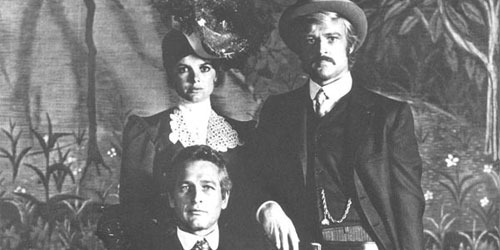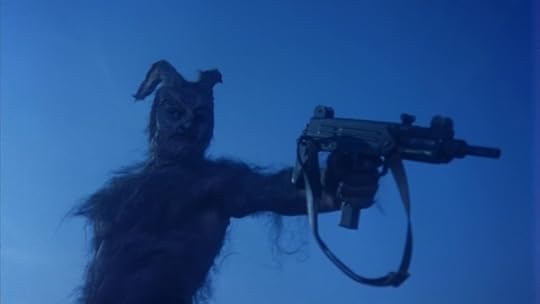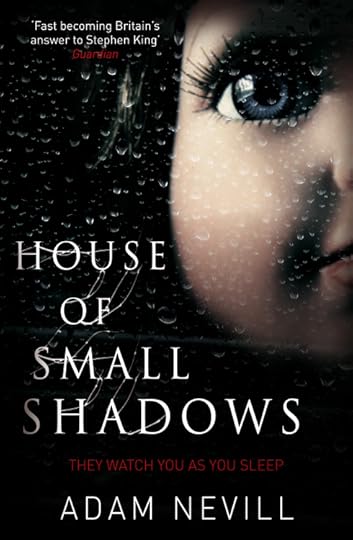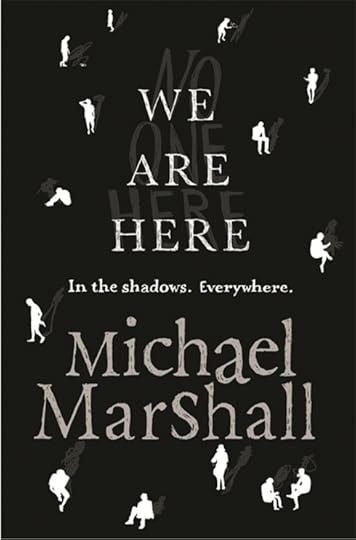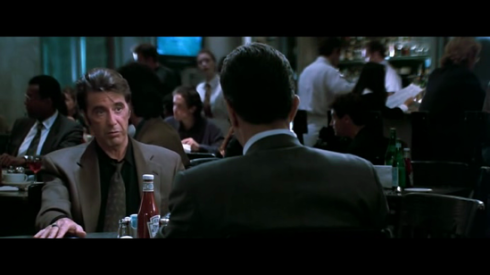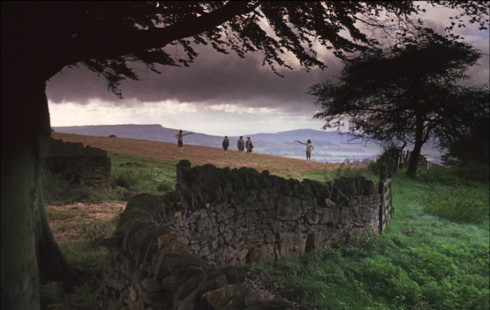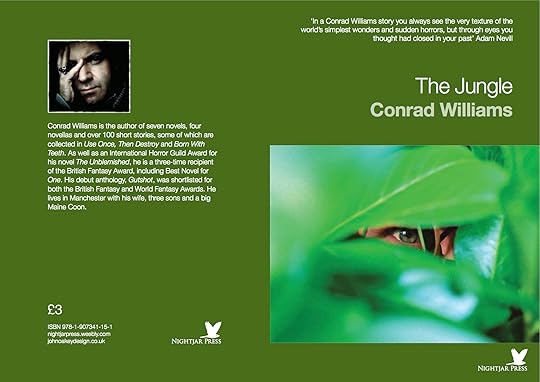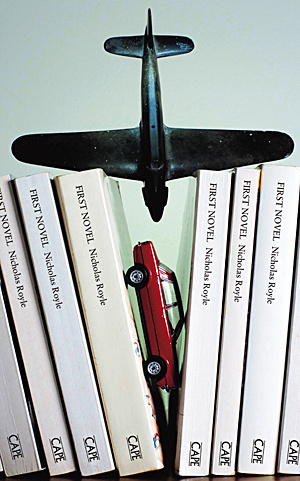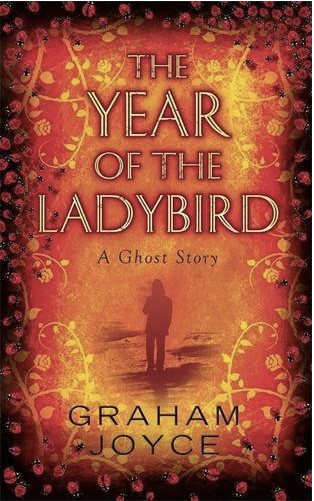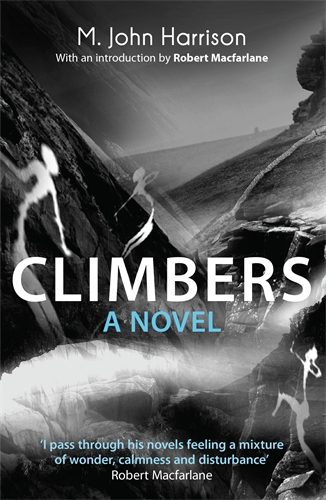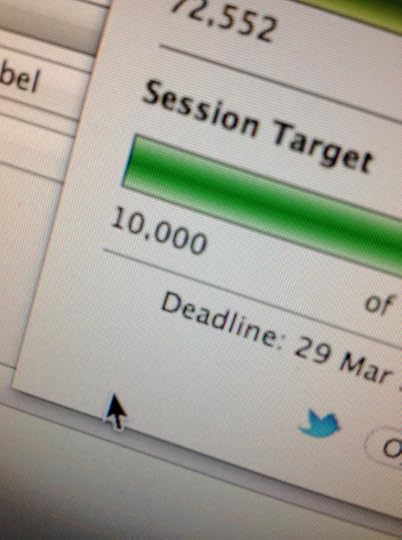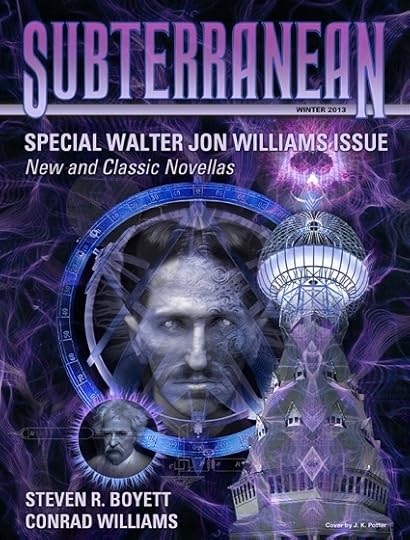Conrad Williams's Blog, page 19
June 20, 2013
My Top Ten non-horror films #7
7 – BUTCH CASSIDY AND THE SUNDANCE KID (1969)
Having watched this and Marathon Man and discovering they were written by the same guy, William Goldman, and not only that but he wrote novels as well, I tracked down many of his books and pigged out on them one summer (I even read Tinsel, for Chrissakes). This film remains his masterpiece, however. A confection, yes, but what an achievement. A perfect film, from the brilliant opening, that segue from sepia to colour, the incredible chemistry between Newman and Redford and the devastating denouement (every time I watch it I think, this time, they’ll get away this time). All students of screenwriting should scrutinise this film.


June 19, 2013
My Top Ten non-horror films #8
8 – SEXY BEAST (2000)
Okay, so it has touches of horror in the shape of that desiccated rabbit… and Ben Kingsley’s turn as sweary psychopath Don Logan puts him very firmly in the human monster category, but this film is more like a modern-day farce. Ray Winstone is the ex-pat crim persuaded to do One Last Job™ and Amanda Redman plays a damaged gangster moll. There is a vein of black comedy running all the way through it, much of it courtesy of Ian McShane as another psychotic, the restrained obverse of Kingsley’s nutjob. Magnificent performances throughout.


Word Count Dependency
I tend to measure my day-to-day progress on a project by the number of words I’ve accrued. It’s easy, straightforward, quantifiable. You know where you stand. If you’re in the hunt for an agent or a publisher, the likelihood is their guidelines will tell you you need to write between 70 – 100,000 words (probably more if you’re writing a genre novel). So you know that if you eke out 1000 words every day for three months – hey presto! – you’re in novel territory. It’s a handy guide, but it can also be somewhat punishing if you’re not careful. Your ‘segments’, if you don’t sand the edges, can have ‘thousand-word chunkiness’, for want of a better description. The joins might show. Also, you feel in thrall to the limit you set yourself, so for example, you might dash through a thousand words and think, that’s my work for the day done, where’s the beach? You switch off. Even if you decide to stick around and do more, internally, you’ve clocked off. Or you might find you’re having one of those days when the words come slower than a legless turtle in a puddle of treacle.
But it’s difficult to get out of that mindset, especially when you consider that many of the legends that went before us worked in the same way. Although not all of them enjoyed it. Graham Greene stopped writing as soon as he hit the 500 word point – his manuscripts are dotted with handwritten numbers where he has counted his output, eager to hit his mark so he could go off to play Russian Roulette or spend the afternoon with a prostitute. What are the alternatives for a writer, someone who is eager to amass a clutch of pages at the end of the day to prove that some marvellous alchemy has occurred?
I asked Adam Nevill, my old editor at Virgin and a superb writer of horror in his own right (check out Apartment 16, The Ritual and Last Days), what his methods were, remembering a discussion we’d once had regarding word counts and work routines, and he sent me this pithy response:
“My lack of awareness of the word count led to a situation while writing LAST DAYS when I noticed I’d hit 140K on the first draft, and remembered there was something about a 120K word length in the contract. And I still had a fair portion of the story to write too. This could have had a major impact on the publisher’s costings for pagination with a print run, so I went hot and cold and informed my editor, who said it was fine and 120K was only a guide (just as well!). The book eventually hit 160K. But that really revealed to me just how little attention I pay to word volume these days. So, I don’t word count and sense that I have harboured a vague prejudice against the practice over the last few years. So answering this question has made me think a bit harder about why I don’t observe a word count now.

Photo: Tania Glyde
“Though it’s not always been the case. I once wrote nine series fiction novels under another name, one per year, to strict deadlines and they could not exceed 80K words or fall much below 75K, so I once watched the counter like a hawk and it was an uncomfortable experience because my tendency was to either go over 80K or under 75K. After one carefully revised and balanced novel hit 86K I was asked to cut “something out” (preposterous!). Also, I remember closing on 70K and knowing another 10K would not be sufficient, and once thinking a story should stop at 70K. Nonsensical. My problem with word limits is similar to my problem with word counts, in that stories cannot be told in the same amount of words, just as they can’t all be told in the same way, and neither can the individual scenes I hope to write in each writing session. So I can’t recall word counting on a novel since 2005 and no word limit has ever been imposed on my horror novels. Instinctively, I always know when a scene, and eventually a story, is finishing. And as every year goes by my inner reader gets better and better at judging pace, so my internal pace measurer is more useful than a word counter. If I counted words, I suspect that going under target on a poor day at my desk would create a lingering indigestion.
“So I approach writing a novel incrementally; I keep in mind what I need to achieve in each new scene, scene by scene, and each new scene has the life and implications of the last scenes within its DNA. But how I reach the end of each respective scene has no relation to the length of the scene in actual words. So I judge the progress of what I am writing, as I go along, by what each scene achieves in relation to the entire story that has past, and what I anticipate is still to come. Each session’s writing is judged by how strong a scene feels and if it works for the story. If a scene comes out quickly, I tend to go away and think on what it means to the next part of the story, rather than blasting straight into the next scene because I feel I am on a roll. So an afternoon or evening thinking about the next scene I need to write, and making notes, is more useful to me than writing continuously. Ultimately, I also don’t trust anything I’ve written until I’ve been through it like a customs official goes through a car that smells of cannabis at a ferry port; the final draft usually occurs around the last month of a deadline, so how many words go down each day until the end is largely irrelevant to the way I think about putting a novel together.
“Writing is an incredibly intense experience too, so I would not want to suffer a conflict about hitting word targets, or find another reason to flagellate myself on the office floor. If I am in the zone I write more; if I take a long time to get into the zone, or life overruns my position, I write less. I always tend to revisit a scene that I am dissatisfied with at the start of the very next session on a first draft, so I don’t need to know how many words are in that scene, because it’s going to be changed. Through good and bad days I eventually finish a novel to my satisfaction and I make sure I end a book feeling excited, as well as feeling a trepidation at having taken risks. I don’t think, wow, I’ve worked so hard I’ve written 160K words this year. I’ve seen a few people on Facebook announce that they have hit one million words in one year; I’m still not entirely sure what that proves.
“On good days the pages come and I lose myself in them, and eventually every part of the story, over successive drafts, will have to be rewritten on a good day; that’s my assurance and word counting would miss the point for me, because volume is subordinate to value, and there is always another way of writing something you know is no good, and everything has to be rewritten. I suspect I actually write better because I don’t count words. Who wants to run a marathon with a stone in their shoe? We’re all different.
“I suppose my equivalent of word counting is an on-going, internal time and motion study. I do reflect on time a lot; how much time in a day, and even a week, I am able to write unimpeded (usually as I am trying to sleep) in lieu of my eventual deadline. I evaluate my progress on the quality of the concentration I had in each session, and how much time I claimed for writing, and how well the scene turned out, not the amount of words that came or did not come. I also often write long hand too, so I couldn’t really count the words anyway.
“So my cold-sweat fear is a valid one: not having enough time to do my best on a book within a year, which is the amount of time I have to write each new book. It’s a good chunk of time. But the terror is good because it makes me find enough time to do my best to finish the best book I can. This is why I more or less stick to one novel a year that I can work on nearly every day, and two short stories each year. Not an arbitrary objective; just the way it has worked out since 2009. This work rate gives me a sense that this schedule is manageable and that I am maintaining quality control. Before I was contracted for one book a year, I didn’t look at the calendar either; I’d know when it was done. So quality writing time and sufficient preparation time is something I do measure mentally on a work in progress, (I would guess for the same motive that some writers count words), because it’s those two things that will decide whether a book is any good or whether it risks failure, not the book’s length. Let’s say I could write 100K words in three months; without putting it to the test, I know it would never be as good as the 100K I could write over a year.
“Short stories are a different case, and most editors seem to want stories at 5K. I struggle to write less than 7K on any story and have even panicked when I notice I have hit 10K. It’s like everything starts evolving into a novel…
“I bet Conrad wished I’d looked at the word counter as I wrote this.”
Another friend, and writer I admire, Michael Marshall (Smith), who is responsible for such novels as The Straw Men, The Intruders and We Are Here, has this to say (excuse the bum-numbing length of his comment):
“I never worry about quantity because I know that, when I’ve worked out what the hell I’m doing, the words and paragraphs will flow easily. Prose and characters seldom if ever give me any trouble once I’ve found the backbone to hang them on. I know I can write 3-4k in a day if I know what I’m doing, so I don’t mind – in fact, I thank God for – the days on which I write seven words, but finally get a sense of what’s supposed to happen next… My writing process is like a very drunk man trying to cross a motorway on foot: long stretches of weaving, watchful stasis, interspersed with chaotic dashes.”

Photo: Steve Double
Many thanks to Michael and Adam for their time…
Word count matters, obviously, otherwise we’d all write Proustian novels that, well, never ended. There’s some instinct within (or more likely contractual obligation enforced upon) a writer that helps to portion a story, give it its rhythms, its peaks and troughs, creates a narrative arc that rises and falls and finds a natural end point within that magical 70-100,000 word zone. It would probably look rather beautiful if you plotted it on a graph. The end result is the important thing, a novel that hopefully reads well and contains all the good things we look for in a story.
What methods do you use?


June 18, 2013
My Top Ten non-horror films #9
9 – HEAT (1995)
For the acting, the photography of LA at night, the thrilling bank heist, that mesmerising exchange in the café, and a final scene that takes the breath away. I never grow tired of watching this. And I want to live in Neil’s beachside property…


June 17, 2013
My Top Ten non-horror films… #10
I’ve been thinking recently about the influences that have helped shape me as a writer since I began trying to do it seriously, over twenty-five years ago. I’d like to share with you the books and films that have made their mark on me. Interestingly (or not, depending on your point of view), much of the media I consider gold star stuff has little, if anything, to do with the genre I tend to favour when I have ideas for novels and short stories. I tend to consider this as an advantage. Obviously I treat my horror darlings with reverence. I’d say that an all-inclusive top ten would contain at least five great horror films – Don’t Look Now, Alien, The Wicker Man, King Kong (1933, natch) and, towering above them all, The Shining, which is quite possibly my all-time number one. My interpretation of what is a horror film will differ from yours, of course. I think Alien is a horror film, for example. Others will see it as a science fiction film. There might even be those who make a case for it as an erotic drama…
A writer, even one with a (spit, sneer) genre bent, should have an omnivorous diet. That said, though there are some films I love to death (the Nolan Batman films, The Lord of the Rings, pretty much anything by Pixar… Toy Story 3 ) this is an animation- and trilogy-free list.
10 – BARRY LYNDON*
Just… phenomenal. Like nothing I’ve ever seen. Stanley Kubrick is my favourite director (my youngest son’s middle name is Stanley). Ryan O’Neal I’d caught before in, um, What’s Up Doc? (actually, not bad), A Bridge Too Far and The Driver. The film chronicles Barry Lyndon’s rise and fall from loveable Irish rogue to tragic physical wreck. Barry Lyndon is languorous and lyrical and decadent and it DOES NOT GIVE A STUFF. The night-time indoor shots are jaw-dropping. Apparently Kubrick used super-fast lenses developed by NASA to shoot scenes lit only by candles. If you haven’t seen it, set aside three hours of your life and wallow in a gorgeously-shot epic, but know this: with Kubrick’s passing, no studio will ever dare make a film like this ever again.
* Obviously this is a list that has changed frequently over the years and also isn’t particularly in ascending order… After I post the No. 1 film I’ll also add a catch-all ‘Bubbling Under’ post that will list all the other films I admire.


May 30, 2013
Didsbury Arts Festival
I’ll be reading at the DAF as Nightjar Press launches two new chapbooks. The event is on Thursday, 27th June at 7pm and takes place upstairs at Pizza Express, 95 Lapwing Lane, Manchester M20 6UR. Admission is free. More information is available here.


May 16, 2013
This is Horror podcast interview
I was recently interviewed by Michael Wilson from This is Horror for a podcast in which I warble about The Fox, writing in general, etc…


April 24, 2013
Dry Run
I’m currently writing a novel loosely connected to two previously published pieces of fiction.
In some cases, chunks of text from both The Owl and Rain have been transplanted into the book. They might be changed slightly – the characters are different, for example, and have to be moulded to fit their new avatars – but essentially what I’ve done is cut and pasted segments of old into a new piece of work, feathering the edges to make sure of a true fit.
I have form, here. Blonde on a Stick contains a chapter that was an unpublished short story from the early 1990s. The Unblemished contains a character, Gyorsi Salavaria, and associative text that was lifted from a short story, Bloodlines, written ten years previously. That novel also contains sections from a short story, Outfangthief, from the same period. It was as if those old stories recognised something in the new stuff I was doing and called out to it. Or maybe that old stuff hadn’t been finished properly, somehow, and the newer me set out to do the material justice without realising it, until those old words started tapping me on the shoulder.
At first I felt as if this was somehow a cheat. Maybe what I was doing wasn’t right, that it was peddling yesterday, that it wasn’t progressive, a sensitive recycling. The reader might notice, causing him to realise he is involved in a process of reading fiction, pulling him out of the story: a grim scenario when we’re in this partly to capture attention. But for me, I sometimes feel as if the novel contains apertures, like those in a jigsaw puzzle, that the relevant, related sections form the short stories fit well, with a little massaging. It helps when influential writers do the same thing…
I spoke to three friends of mine who all work in a similar way, and it was interesting to get their responses in relation to why they go back to earlier work as a starting point for, or an adjunct to something new.

Photo by Conrad Williams
Nicholas Royle’s new novel, First Novel, is his seventh. He is also a prolific short story writer.
When I’m starting to think about a new novel I will try out certain ideas in the form of short stories. I’m aware that stories and novels are different things and I know that by the time it comes to folding these early thoughts into the novel they will probably have changed shape. Often, endings imposed for the sake of the short story form will go, and other, less visible work will be done as part of the folding-in.

Photo by Charlie James
Graham Joyce, author of The Silent Land, Some Kind of Fairy Tale and, soon, The Year of the Ladybird, does things a bit differently. His stories An Ordinary Soldier of the Queen (from Memoirs of a Master Forger) and The Coventry Boy (from Facts of Life) came into being after the novels in which they were couched had been completed.
I tend to be a bit too much fascinated with “stories within stories” structures (I blame Scheherezade) but I usually know at the outset if it it will work as a standalone. I might finesse the head and tail of the story to sell it as a standalone. The thing is the aesthetics remain untouched.

Photo by Cath Phillips
M John Harrison’s novels include The Course of the Heart, Signs of Life, Light, Nova Swing and, most recently, Empty Space. Climbers, his brilliant novel from 1989, is about to be reprinted.
It’s an article of faith with me, part of a method.
(a) I’m an obsessive. I deal very heavily in repeating images & obsessive affects. No one complains that Dali or Ernst or Picasso used the same imagery over & over again. It seems to work for painters, why not writers. & of course you see obsessive repetition as technique in people like Ballard, Anna Kavan, many of the 50s & 60s nouveau roman authors, who were interested in breaking down narrative structures & looking for organisational methods from other kinds of discourse.
(b) I don’t see fictions as being discrete, or ever “finished”. Something which is totally itself in one incarnation becomes part of something else in another. I work by bolting bits together to see what they make. The boundaries of a piece are like those chemical sites on viruses that allow them to bind to cells; change the sites, top & tail the segment, & it’ll fit somewhere else, become something else. Guess I’m a structuralist. But I also think it’s a way of entertaining the reader by showing them your process.
As subject matter, I like the idea of contexts switching suddenly to become subjects, subject that flips to context; works well at the technical level too. I do test-bedding of novels as shorts, the topping & tailing of shorts so that they become chapters in novels, blog pieces that become bits of shorts, shorts that break up & get scattered as blog posts or tweets; but, really, that’s because any given component suggested all those possible relations during the process itself. If it’s fluid for me, let it be fluid for the reader. Nothing really “exists”: everything that seems solid in the universe is made of the dynamic relations between structures at the next level down.
So I see the whole thing as a kind of fluid momentum. Not as discrete products.
I feel I’m justified (and in sterling company) when it comes to refashioning some of that old material in order to service the current story, if it’s sympathetically done, and feels right. The work all shares the same blood, after all.
Thanks to Nick, Graham and Mike for their time.


February 4, 2013
10K
On Friday, January 11th this year I did something I’ve never done before and doubt I will ever do again. I wrote 10,000 words in one day. The last time I performed anywhere like that was in 1994, the night before I had to hand in my MA dissertation. I think I wrote about 6000 words back then, fuelled by fear, coffee and the all-nighter mentality that a 25-year-old can frequently muster.
Last month, though, I wasn’t under any kind of pressure. I’m currently writing two novels – one, a commission with a July deadline, the other just a ‘me’ project with no contract or publisher attached. The only deadline it has is the one I impose upon it. I’d like to get it done by my birthday, though, on March 29th. So far, the commissioned novel (Project Eyeshine) is 40,000 words in and Project Bayonet, which has occupied me off and on for the past couple of years, is 63,000 words and counting. I had written a thousand words by lunchtime on Bayonet, and decided to switch my attention to Eyeshine. I knew what I wanted to write, so I knuckled down with the headphones on (Hans Zimmer’s excellent Batman soundtracks, if you must know), the internet off and a little app called Pomodoro ticking away. By 5pm, four-and-a-half hours later, I raised my weary head to find I had written 8000 words. Before bed, having rallied, I wrote another thousand on Bayonet, which took me over the magical 10K mark…
I wouldn’t necessarily encourage you to follow my lead. I was shattered by the end, and knew that much of what I’d written would need some tough editing, but if you do fancy having a crack at a big writing day I’d urge you to do the following:
Make sure you have two or three chapters planned out: know where you’re taking the story.
Find yourself a big block of time and insist that you aren’t disturbed.
Use an app such as Freedom to lock you out of the internet (or switch off your network connection and don’t give in to the temptation to switch it back on…).
Use the Pomodoro technique as a way of blitzing through your work: 25 minutes of hard graft, followed by a five-minute break. Four cycles of this grants you a 25-minute break, then back to square one. It really helps to focus you.
I hope I can enjoy a working day like that again, but it doesn’t really matter if I don’t. Little and often is better than a huge splurge and the misguided belief that you can then take a day or two off…
Even if your aim is to up your daily word count (or just get some work done!), something like Pomodoro combined with Freedom can help increase output over shorter periods.
Fewer Lolcats, more pages…



